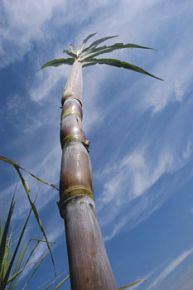
EDUARDO CESARIt is possible to identify the most productive sugarcane by its molecular makeupEDUARDO CESAR
A new genetic tool for the formation of new varieties of sugarcane, more productive and less susceptible to drought and to diseases, has been constructed by a team of researchers from the State University of Campinas (Unicamp). It is the functional map of the sugarcane that shows molecular markers relating to the plant’s agronomic characteristics, such as, for example, the genes connected with the biosynthesis of sucrose, the scientific name for sugar. The importance of this finding is that, besides acting as a sweetener in the day-today, sucrose is fundamental in the process for producing ethanol, or automotive alcohol.
“We drew up a map with genes that act as molecular markers”, says agronomist engineer Anete Pereira de Souza, the coordinator of the study and a professor from the Genetics and Evolution Department of the Biology Institute and a researcher with the Molecular Biology and Genetic Engineering Center (Cbmeg), both at Unicamp. “These markers are small variations is the sequences of the nitrogenous bases that make up a gene (guanine, cytosine, thymine and adenine) and may be associated with commercially interesting characteristics.”
The identification of these genes started from the results of the Sucest, the abbreviation for Sugar Cane EST (expressed sequence tags, corresponding to an organism’s expressed or active genome), better known as Sugarcane Genome, carried out between 1999 and 2003 by about 240 researchers from universities in São Paulo, Pernambuco and Rio de Janeiro. The work resulted in getting to know about 90% of the sugarcane genes, represented by 43 thousand expressed sequences of genes. The technique used was to develop microsatellite-type markers from expressed sugarcane sequences, to construct later the functional map and locate the genes in the genome of the species.
The genes of an individual of the same species are the same; what changes are the small variations in these genes, called alleles, which can identify such differences as the color of the eyes, of a flower, or even paternity, in the so-called DNA tests. A gene may have various alleles, which are variations of this gene. “The difference between alleles may determine, for example, a more efficient metabolism for producing sugar, or resistance to diseases and also to drought, for example”, explains Anete, who, in January, received a favorable opinion for publishing the functional map of sugarcane in the Molecular Breeding scientific magazine.
With the details of the molecular markers to hand, it is possible to analyze a population of productive plants and to see which individuals have the alleles associated with the production of sugar, for example. It is possible to find alleles that encode proteins with a greater commercial interest. “Our work is to identify the favorable alleles in the genome.” Amongst the 400 or so genomes analyzed, from 2-thousand sequence that had microsatellites, many could be transformed into molecular markers, making it possible to map then in the sugarcane genome.
Ideal offspring
The functional map makes it possible to identify the most productive plant by its molecular makeup. Genetic differentiation identifies, for example, sugarcane plants that, albeit productive in sugar, have little resistance to diseases, or vice-versa. Identifying the gene makes it possible to crossbreed two plants that have the best alleles, guaranteeing an offspring with the best desirable agricultural characteristics.
Molecular research with sugarcane and a future systematization of the genetic tests will be a technological advance for the professional improvers who do the crossbreeding between plants (the manual exchange of pollen between two plants of different varieties), always seeing the best external characteristics, called phenotypes, in a given plant population for forming more productive new varieties. “They may also use molecular data in the choice of the best plants for carrying out crossbreeding”, says Anete.
The studies of the group from Unicamp were also able to count on researchers from the genetics department of the Luiz de Queiroz College of Agriculture (Esalq) and from the Agriculture Nuclear Energy Center, both of the University of São Paulo (USP), and had financing from FAPESP’s Partnership for Technological Innovation Program (PITE) and from the Sugarcane Technology Center (CTC), an association maintained by over a hundred independent mills and 15 associations of producers. “The studies were carried out using a population made up of a hundred plants, obtained from controlled crossbreeding between plants of two pre-commercial varieties from the CTC’s genetic improvement program.”
The CTC is now using the specific molecular markers found in the study to identify whether a plant is a variety produced by them. That has implications for the charging of royalties from the farmers by the center. Another of the group’s result was the development of a new methodology for constructing statistical genetic maps. The group of Professor Antônio Augusto Franco Garcia, from Esalq, created a software specially for the work. “Instead of two maps (one for the father and the other for the mother of the plant), superimposed for the verification of the offspring, they constructed just one map.” The group’s next step is to work together with the CTC and the group of Professor Gláucia Mendes Souza, from the Chemistry Institute at USP. In a similar project, she identified other genes of a commercial interest that do not have microsatellites. The method used by her is an analysis by microarrays or chips of DNA in which the gene is located amongst thousands of others, and it has to be tested in the field.
The Project
Development of molecular markers from ESTs of sugarcane to select economically important characteristics (nº 02/01167-1); Modality Partnership for Technological Innovation Program (PITE); Coordinator
Anete Pereira de Souza – Unicamp; Investment R$ 172,403.00, US$ 45,495.22 (FAPESP) and R$ 103,675.30 (CTC)
